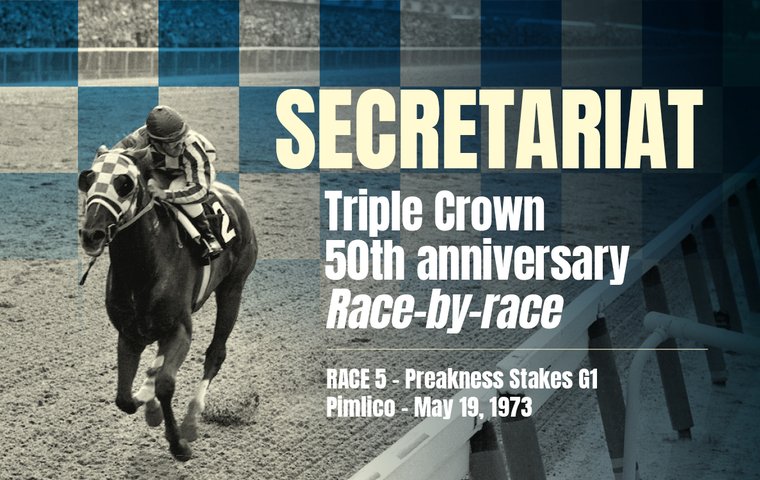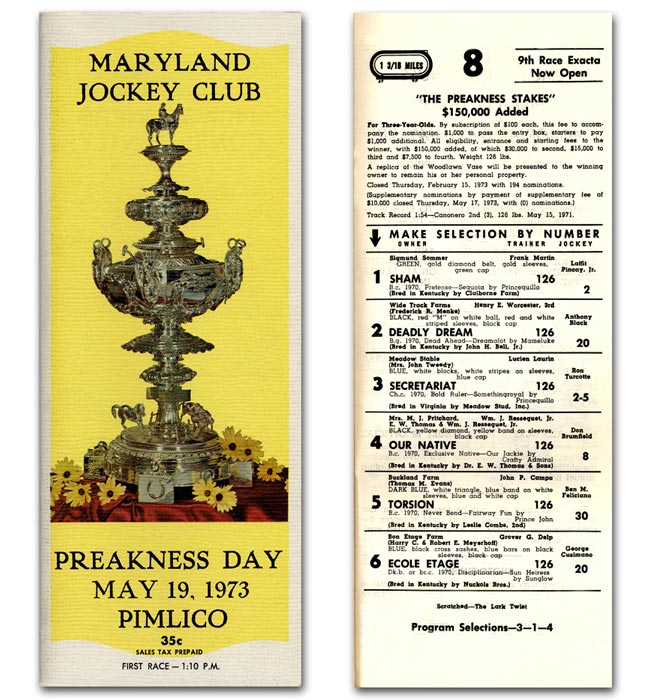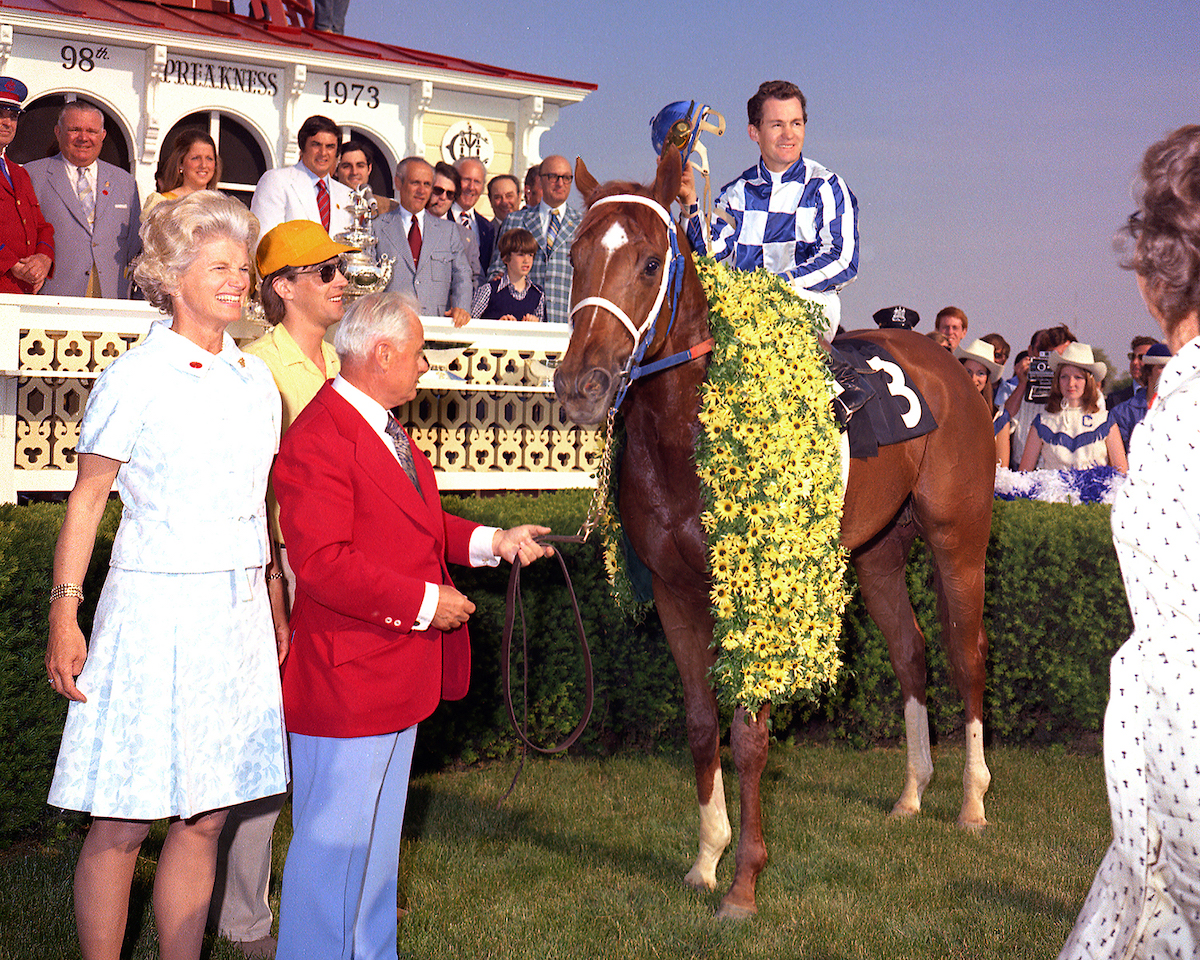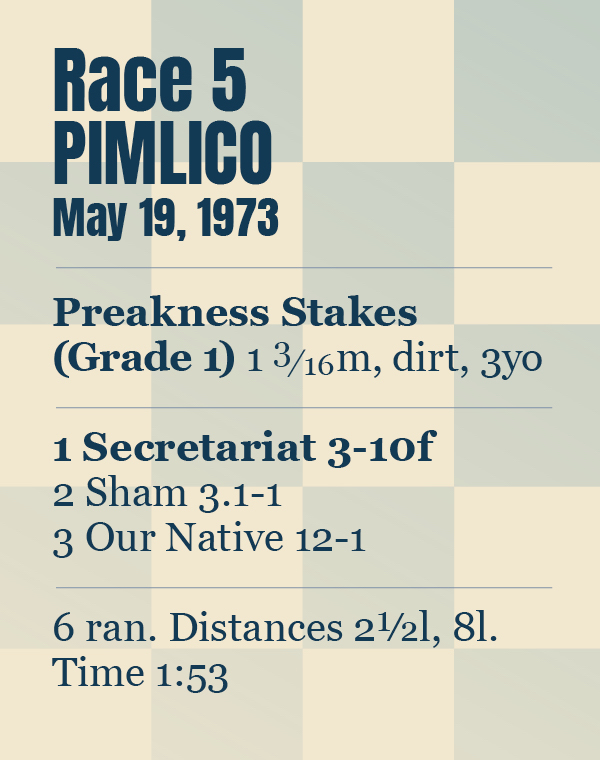
Thoughts of the Triple Crown came into sharp focus as Secretariat headed for the Preakness Stakes and another clash with arch-rival Sham. In the latest instalment of his popular series, Steve Dennis recalls the Pimlico Classic – and an error of history it took nearly four decades to rectify
With his record-breaking victory in the Kentucky Derby, Secretariat, the six-million-dollar horse – he had been syndicated for stud purposes for $6.08m before his first race at three – had justified both his valuation and his reputation, his pre-eminence no longer in any doubt.
Now the Triple Crown was on the table, and the second jewel in that elusive triptych of brilliance was the Preakness at Pimlico, where Big Red would renew his thrilling rivalry with Derby runner-up Sham.
A Preakness far above the norm
The Preakness, self-evidently, is neither the Kentucky Derby nor the Belmont Stakes, and suffers a little in comparison. The Kentucky Derby is America’s greatest race, only the Belmont can anoint a Triple Crown winner, and the Preakness is the stepping-stone between them, the process not the prize. The poor Preakness.
 But there were two things about the 1973 Preakness that raised it far above the norm, lifted it from the mean to the empyrean. One of those things lasted a matter of seconds, the other took 39 years to reach the finish line, and the seismic effects of both are felt to this day.
But there were two things about the 1973 Preakness that raised it far above the norm, lifted it from the mean to the empyrean. One of those things lasted a matter of seconds, the other took 39 years to reach the finish line, and the seismic effects of both are felt to this day.
There were no concerns in the Secretariat camp through the fallow fortnight between the Derby and the Preakness. There were no newspaper stories querying the great colt’s stamina, or his soundness, or his suitability; everything had been answered by his majestic performance at Churchill Downs.
Everyone was delighted with Secretariat, and trainer Lucien Laurin and jockey Ron Turcotte felt the same way after the son of Bold Ruler tore up the track in a workout six days before the big race, when he blew through a half-mile in 45⅕s.
The Derby had taken little out of him, and neither had the relentless spring schedule that made the Preakness his fifth race in 64 days. He was 2-5 on the morning line to beat five rivals, although there were still those who believed that Sham had it in him to beat Secretariat again, as he had in the Wood Memorial.
One such was Sham’s trainer, the colourful, combustible reporter’s dream Frank ‘Pancho’ Martin, who held court for Secretariat’s biographer William Nack in hyperbolic fashion.
“If I don’t win, I’ll be very, very, very, very disappointed,” he said, holding up his fingers so that Nack wouldn’t lose count. When Martin encountered disappointment, he really felt it. “I don’t think the Derby was a true race. I think Sham is going to win easy, believe me.”
Some did, and bet accordingly. Sham, partnered again by Laffit Pincay, was 2-1 to win, easy or not, while Derby third Our Native was expected to hit the board again at 8-1.
The remaining three runners – Ecole Etage, Deadly Dream and Torsion, an old friend from the Bay Shore, who had gone at Secretariat like a linebacker in that race but failed to make him drop the ball – were simply among those present on a bright blue Maryland afternoon. They could have been included in the record attendance of 61,657 for all the chance they had. Perhaps they were.
Emphasis on speed
Of the three Triple Crown races, the Preakness – the shortest at a mile and three-sixteenths, at comparatively tight Pimlico – places the greatest emphasis on speed. This was on Turcotte’s mind as Secretariat broke well from post three before being rated back to sit last of the half-dozen, as Ecole Etage dashed off like the Pony Express towards the clubhouse turn, jockey George Cusimano scrubbing at his neck like Saturday was washday.
Torsion was behind him with Sham on his inside, both going fast. Secretariat, comparatively dawdling along, was 12 lengths off the lead as they crossed the line for the first time. And then Turcotte moved his hands, just a little, softly, subtly, like a magician working a trick, and the race changed in an instant.
Secretariat leaned into the bit and took off running, angling outside Our Native and Deadly Dream. No horse could be expected to make such a move so early, so decisively, but Secretariat did and in three strides the Preakness was altered beyond recognition.
“I let my horse drop back, and when I went to drop in they started backing up into me,” said Turcotte. “I thought ‘I don’t want to get trapped here’, so I just breezed by them.”
It happened before anyone had a chance to rationalise the situation. Secretariat moved to Sham and, in words used at another time, in another place, ran right by him. He inhaled Torsion. He caught Ecole Etage in two strides and left him behind in two more. He was free on the lead. Where the Derby had been a slow burn, each quarter run faster than the one before, the Preakness was pyrotechnics. Boom! went the dynamite.
‘Never seen anything like that horse’
“I never seen anything like that horse, moving so early and having so much left,” said Deadly Dream’s jockey Tony Black, who caught a chill twice over when Secretariat swooshed past him. “I was on the inside, Secretariat on the outside. Next thing I know, Secretariat’s gone. He’s unreal.”
A photographer standing at the clubhouse turn – Raymond Woolfe, for the Daily Racing Form – caught the move at its genesis, the fraction of a second when Secretariat slipped the surly bonds of earth and flew, his legs thrown out before him as though he was pouncing on prey, a masterpiece of power and grace and beauty.
The photo was used as the basis for the John Skeaping statue of Secretariat that stands in the paddock at Belmont Park, a permanent reminder of the Preakness move that so stunned the watching world.
After that, the rest was almost anticlimax. Secretariat had broken the race apart and, as in the regrettable case of Humpty Dumpty, no-one could put it back together again. The red horse eased two and a half lengths clear around the turn and although Sham was in hot pursuit, with a frantic Pincay going to the stick again and again, he simply could not close the gap by even a yard. Pancho Martin was about to be very, very, very, very disappointed.
Turcotte peeked under his right arm once, twice, three times but never moved his hands again, his stick an unnecessary accessory, and Secretariat was still two and a half lengths clear of Sham when he crossed the line. Our Native came along in his own time for third, the first three in the Derby the first three in the Preakness for the first time ever, with the margins between them identical.

The time was 1:55 flat. Wait! Hasn’t somebody made a mistake?
Yes, they had. And it took 39 years to put it right.
The clock was wrong. The electric timer had malfunctioned, the most obvious manifestation of its blunder being its assertion that Ecole Etage had ambled through the first quarter in 25s flat, when to every eye he was blitzing it far faster than that.
The aberration was quickly recognised, and two days later Pimlico’s top brass issued an official finishing time of 1:54⅖s, as supplied by the track’s specialist stopwatch man. Yet two clockers from the Daily Racing Form had recorded Secretariat’s time as a full second faster, beating Canonero’s 1971 mark.
Sulky footnote
The inexactness rankled, especially as the DRF time would have been a track record to go with Secretariat’s Derby track record, another garnish on his greatness. And so for years the official time was only grudgingly accepted, with the DRF using its clockers’ time as a sulky footnote on the race charts.
Modern technology came to the rescue. In 2011, Leonard Lusky, who had worked as a technical adviser on the Hollywood treatment of Secretariat, embarked upon a nine-month study in obsession that involved watching the Preakness in reverse and examining the position of the horses when the allotted time had elapsed.
 In the US, the clock starts not at the gate but at a pole roughly 20 yards away, and Lusky discovered that Secretariat was still in the gate at the back-to-front time of 1:55. The electric timer had incorrectly started when the gates opened. Further research indicated that Secretariat had, in fact, run even faster than the DRF clockers had believed.
In the US, the clock starts not at the gate but at a pole roughly 20 yards away, and Lusky discovered that Secretariat was still in the gate at the back-to-front time of 1:55. The electric timer had incorrectly started when the gates opened. Further research indicated that Secretariat had, in fact, run even faster than the DRF clockers had believed.
At a presentation attended by Secretariat’s owner Penny Chenery, Lusky could show beyond any doubt that Secretariat had run the Preakness in 1:53 flat, a track record then and a stakes record now. The new, improved time meant that Sham had also slipped inside the old mark, as he had done at Churchill Downs.
‘Evidence was totally convincing’
“The evidence was totally convincing,” said Maryland Racing commissioner John McDaniel. “Injustice was done, and we needed to correct it.”
Rewind the tape, the years, back to the afternoon of May 19, 1973, and the giddy aftermath of the 98th Preakness Stakes. That’s another mild slight upon the poor Preakness – add it to Derby glory, and everyone inevitably just wants to look past it and talk about the Belmont. Stamina for the mile and a half, a fairly unorthodox distance then and an archaic anomaly in these days of a near-religious devotion to speed, is always the first question, and Turcotte fielded it adroitly.
“He sure seemed like he’d stay the distance,” he said, his knowledge of the Belmont’s demands sharpened by his victory in the race the previous year aboard the red horse’s barnmate Riva Ridge. “I wasn’t persevering with him and he was strong at the finish.”
Less than a month earlier, after the Wood Memorial, plenty were dismissive of Secretariat’s ability to stretch out to ten furlongs, and now here he was with another quarter-mile on his plate. Could a Bold Ruler colt run a mile and a half? In three weeks’ time, we’d all find out.
• Visit the dedicated Secretariat website at secretariat.com
Race 2: ‘I think we should send this horse today’ – time for a change of tactics in the Gotham
Race 1: ‘I made a mistake’ – more trouble than expected as Secretariat sets out for greatness
View the latest TRC Global Rankings for horses / jockeys / trainers / sires


